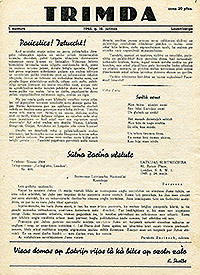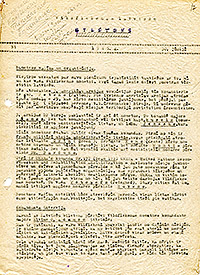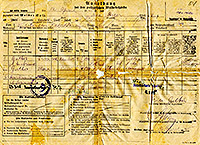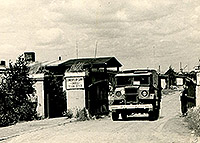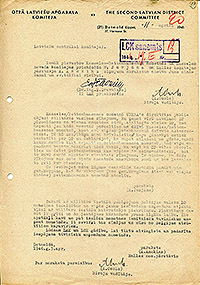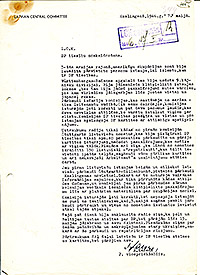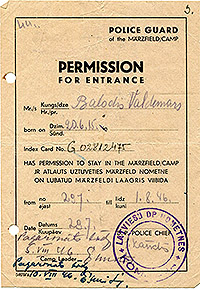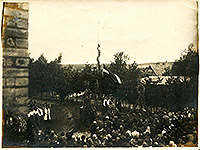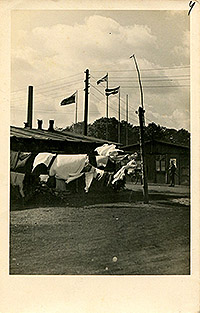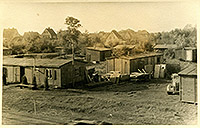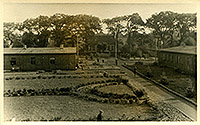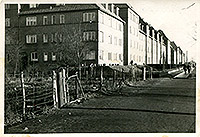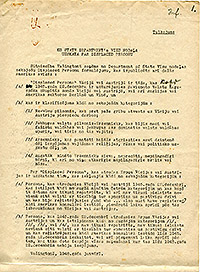DP camps in Germany
In the summer of 1945 the Latvians in West Germany were situated in over more than 300 refugee camps maintained by the UNRRA (United Nation Relief and Rehabilitation Administration – founded in 9 November 1943).
Refugees were officially referred to as the displaced persons (abbreviated as DP). Within the period between 1945 and 1951 the biggest refugee camps/centres in Germany were: with the population of 2500 – 5500 — Esslingen, Würzburg, Nurnberg and Lübeck; but with the population of 1000 – 2500 — Amberg, Gesthaht, Augsburg, Fischbach, Manheim, Eichstätt, Hanau, Flensburg, Alt Garge, Märbeck, Ravensburg, Husum, Schleswig, Ansbach, Greven, Hersbruck, Karlsruhe, Kleinkötz, München, Oldenburg, Regensburg, Spakenberg, Weiden.
| First edition of Lauenburg periodical "Trimda". 18 June 1945. LVA, 1971. f., 5. apr., 82. l., 1. lp. |
|
| Latvian newsletter of the Wildflecken camp. 30 June 1945. | |
| Temporary registration card. LVA, 2250. f., 2v. apr., 6. l., 52. lp. | |
| Registration form in the police office. LVA, 2250. f., 2v. apr., 6. l., 54. lp. | |
| DP camp photography. LVA, 2335. f., 1. apr., 386. l., 10. lp. | |
| Würzburg Latvian refugee camp. LVA, 2335. f., 1. apr., 402. l., 17. lp. |
In 1946 UNRRA started to close down the small camps by means of merging and creating bigger camps. On 1 July 1947 care for refugees was taken over by the IRO (International Refugee Organisation) who continued reorganisation of the camp network and uniting of the small camps. Sometimes camps were moved to rearrange them according to ethnicity, creating separate camps in which people of the same ethnicity were accommodated.
| Report from second Latvian district committee to the Latvian Central Committee about UNRRA order to the refugee camps. 11 April 1946. LVA, 2335. f., 1. apr., 55. l., 93. lp. |
|
| Latvian Central Committee information on the legal status of DP. 7 May 1946. LVA, 2335. f., 1. apr., 55. l., 105. lp. |
|
| Permit to reside in the DP camp. Year 1946. LVA, 1971. f., 1v. apr., 66. l., 3. lp. |
|
| Consecration of the flag in Latvian refugee camp "Saule" LVA, 2250. f., 2v. apr., 12. l., 6. lp. |
|
| Flags of Great Britain, Latvia and Lithuania in refugee camp’s English occupation zone. LVA, 2250. f., 2v. apr., 76. l., 4. lp. |
|
| Latvian refugee camp "Tçrvete" in Oldenburg. Years 1945-1948 LVA, 2250. f., 25v. apr., 1. l., 1. lp. |
|
| Latvian refugee camp "Tçrvete" in Oldenburg. Years 1945-1948 LVA, 2250. f., 25v. apr., 1. l., 5. lp. |
|
| Latvian refugee camp in Lübeck LVA, 2250. f., 25v. apr., 1. l., 22. lp. |
|
| Explanatory note on Displaced person distributed by Embassy of Latvia in Washington. January 1948. LVA, 1971. f., 1.apr., 64. l., 1. lp. |
In 1949 new reasons arose for reorganisation of refugee camps in relation to the increasing number of emigrating people and gradual transfer of refugees under German administration. The remaining refugees were concentrated in particular areas. In 1949 implementation of the IRO plan whereby camps were established for special categories of refugees depending on the options to settle them in immigration countries was started. There were separate camps for the displaced persons – the so-called emigration camps and emigrant passage camps . Special camps were established for ill and old persons who were not able to emigrate or start independent life outside the camp.
